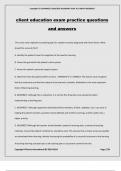Copyright © OLIVIAWEST 2024/2025 ACADEMIC YEAR. ALL RIGHTS RESERVED
client education exam practice questions
and answers
The nurse must implement a teaching plan for a patient recently diagnosed with heart failure. What
should the nurse do first?
A. Identify the patient's level of recognition of the need for learning
B. Frame the goal within the patient's value system
C. Assess the patient's personal support system
D. Determine how the patient prefers to learn - ANSWER✔✔-A. CORRECT: The learner must recognize
that the need exists and that the material to be learned is valuable. Motivation is the most important
factor influencing learning.
B. INCORRECT: Although this is important, it is not the first thing the nurse should do before
implementing a teaching plan.
C. INCORRECT: Although supportive individuals (family members, friends, neighbors, etc.) can assist in
helping the patient maintain a positive mental attitude and reinforce learning, another option has a
higher priority.
D. INCORRECT:Although the teacher should identify a patient's learning style, a variety of teaching
methods, not just the patient's preference, should be used. This ensures that as many senses as possible
are stimulated when learning, thereby increasing the probability of a successful outcome to the learning
A teaching-learning concept basic to all teaching plans is to present content from the:
Copyright ©Stuvia International BV 2010-2024 Page 1/39
, Copyright © OLIVIAWEST 2024/2025 ACADEMIC YEAR. ALL RIGHTS RESERVED
A. Cognitive to the affective domain
B. Formal to the informal
C. Simple to the complex
D. Broad to the specific - ANSWER✔✔-A. INCORRECT: Teaching and learning involve one or all domains
of learning and do not move from one to the other in progressive order. Cognitive learning involves the
intellect and requires thinking. Cognitive learning increases in complexity from knowledge to
comprehension, application, analysis, synthesis, and evaluation of information. Affective learning
involves the expression of feelings and the changing of beliefs, attitudes, or values. Affective learning
increases in complexity from receiving to responding, valuing, organizing, and characterizing. In addition,
there is the psychomotor domain, which is related to mastering a skill and requires motor activity.
Learning in this domain increases in complexity from readiness to take action to a guided response,
mechanism, complex-overt response, adaptation, and origination.
B. INCORRECT: Teaching methods that are formal or informal
are equally effective. The key is to select the approach that is most likely to be effective for the individual
learner. This depends on a
variety of factors, such as intelligence, content to be taught, learning style preferences, available
resources, reading level, etc.
C. CORRECT: Complex material is best learned when easily understood aspects of the topic are presented
first as a foundation for the more complex aspects. When moving from the simple to the complex, a
person works at integrating and incorporating the less complex, new learning into one's body of
knowledge and understanding before moving on to more complex information.
Copyright ©Stuvia International BV 2010-2024 Page 2/39
, Copyright © OLIVIAWEST 2024/2025 ACADEMIC YEAR. ALL RIGHTS RESERVED
D. INCORRECT: There is no documented principle that supports the need to present content in the
direction of broad to specific rather than specific to broad. Each individual patient and the information to
be taught will influence the direction in which content is taught.
The nurse is planning a teaching plan for an older adult. Which common factor among older adult
patients must be considered by the nurse?
A. Learning may require more energy
B. Intelligence decreases as people age
C. Older adults rely more on visual rather than auditory learning
D. Older adult patients are more resistant to change that accompanies new learning - ANSWER✔✔-A.
CORRECT: Various physiological changes of aging impact on the rate of learning (declines in sensory
perception and speed of mental processing, and more time needed for recall) requiring the use of
multisensory teaching strategies and a slower approach.
In addition, older adults may have less physical and emotional stamina because of more chronic
illnesses, so they may require shorter and more frequent learning sessions.
B. INCORRECT: Although some older adults may experience
a decline in short-term memory, they are not less intelligent. When older adults experience a decline in
sensory function (vision,
hearing), they may feel ashamed or frustrated, causing withdrawal. Behaviors reflective of withdrawal
may be misperceived as a decline in intelligence.
C. INCORRECT: This is not necessarily true. Individuals usually have learning preferences that persist
throughout life.
Copyright ©Stuvia International BV 2010-2024 Page 3/39
, Copyright © OLIVIAWEST 2024/2025 ACADEMIC YEAR. ALL RIGHTS RESERVED
D. INCORRECT: Older adults generally are not resistant to change. Some older adults may be less
motivated to learn if they believe that death is near. However, in this situation when older
adults are shown how learning will improve quality of life and independence, they are motivated to
learn.
The nurse is teaching a postoperative patient deep breathing and coughing exercises. Which method of
instruction is most appropriate in this situation?
A. Explanation
B. Demonstration
C. Video presentation
D. Brochure with pictures - ANSWER✔✔-A. INCORRECT: This is not the best approach to teach a
psychomotor skill. An explanation uses words to describe a behavior that the learner then has to
attempt to perform.
B. CORRECT: A demonstration is the best strategy for teaching a psychomotor skill. A demonstration is an
actual performance
of the skill by the teacher who is acting as a role model. A demonstration usually is followed by a return
demonstration.
The learner can imitate the teacher during a return demonstration, ask questions, and receive feedback
from the instructor.
C. INCORRECT: Although a video provides a realistic performance of the skill, it does not allow for
questions or feedback.
D. INCORRECT: A brochure with pictures is too static and unidimensional for teaching a psychomotor skill
Copyright ©Stuvia International BV 2010-2024 Page 4/39




